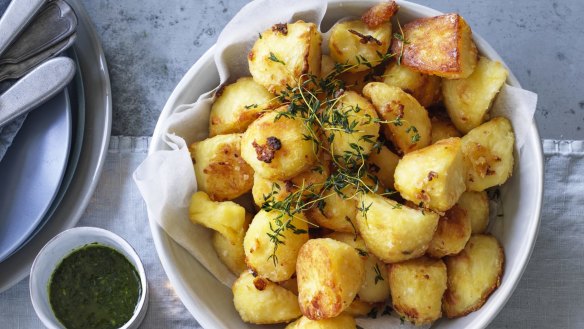The secret to perfectly crunchy roast potatoes

How do I get crispy roast potatoes? M. McKay
A great deal of cooking was done over winter including the simmering of a lot of stock and the roasting of a lot of potatoes. The unintended consequence of making so much chicken stock was the schmalz, or chicken fat. I discovered, much to my arterial system's despair, that chicken fat is almost as good as duck fat in which to roast potatoes. I also discovered that potatoes par-boiled in well-seasoned chicken stock are even more delicious as the potatoes absorbs the flavour of the stock. To make crunchy potatoes, drain them, place them in a bowl and immediately coat them in fat – chicken, duck, beef or ham fat (see below), olive oil or butter. Season, then let them cool. By doing this the fat melts and soaks into the top layer of hot, soft potato. As they cool, the starch hardens, creating a fat-laden coating. Turn the oven to 160C fan-forced (180C conventional) and heat a heavy roasting pan for 15 minutes. When hot, add the potatoes and roast for 1 hour and 20 minutes, turning the potatoes every 20 minutes, until the potatoes are deep gold and crunchy.
I find there is so much waste from a Christmas ham. Any idea what to do with the skin, bone and fat? A. Van Buren
I think many of us have summer memories of the ham that hung around too long. The holiday house by the beach. The ham wrapped in an old pillowcase and stuffed into a febrile Kelvinator. The musty aromas and white fungal bloom developing on the prized ham, putting the family off their cold potato salad. Consider buying a half ham to avoid waste from the outset. If there is leftover ham, consider making croquettes. Chop ham, leftover chicken and turkey finely and add to thick bechamel sauce. Spread the mixture out on a tray, cover and refrigerate. Portion into tablespoon-sized scoops and fashion into a tube or Aussie Rules footy shape with wet hands. Coat in flour, dip in egg wash, dredge in panko crumbs and deep-fry. Alternatively, if you have enough ham leftover, make the classic French ham terrine jambon persille, a Burgundian terrine of wine-poached ham interlaced with a summery layer of fine jelly and minced parsley. Make a stock with the bones and ham scraps by placing them in a stock pot with a few carrots and an onion, cover with water and simmer for several hours, skimming the surface frequently. Drain into a large bowl and discard bones. (The carrot and onion, finely chopped, can go into the croquettes.) Ham stock can be salty and may need to be diluted for use in soups, but it's ideal for par-cooking potatoes before roasting, or boiling potatoes to make a cold potato salad. Ham fat can be rendered into lard and used for shallow-frying or roasting potatoes (see above). Remove the fat from the skin and the connective tissue, chop finely, and place in a heavy-bottomed pan covered with water. Simmer gently for several hours until the fat has rendered. Strain the hot molten fat through a fine metal sieve into hot, clean jars. Seal and refrigerate. It will keep for several months. If the skin is unglazed and dry, you can turn the skin into crackling. Cut the skin into strips, cover a tray with paper towels and place the skin on top. Leave uncovered in the fridge for 24 hours. The next day, preheat a pan of oil to 180C and deep-fry the skin until golden. Depending on how it was cured it may be quite salty.
Send your vexing culinary conundrums to brainfood@richardcornish.com.au or tweet to @foodcornish
Appears in these collections
- More:
- Food
- Brain food
